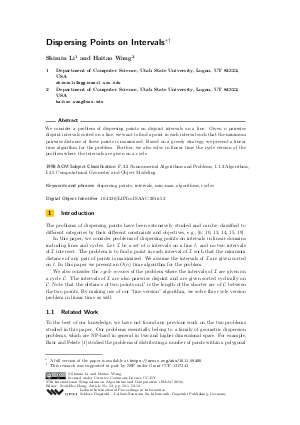Dispersing Points on Intervals
Authors Shimin Li, Haitao Wang
-
Part of:
Volume:
27th International Symposium on Algorithms and Computation (ISAAC 2016)
Part of: Series: Leibniz International Proceedings in Informatics (LIPIcs)
Part of: Conference: International Symposium on Algorithms and Computation (ISAAC) - License:
 Creative Commons Attribution 3.0 Unported license
Creative Commons Attribution 3.0 Unported license
- Publication Date: 2016-12-07
File

PDF
LIPIcs.ISAAC.2016.52.pdf
- Filesize: 0.57 MB
- 12 pages
Document Identifiers
Subject Classification
Keywords
- dispersing points
- intervals
- min-max
- algorithms
- cycles
Metrics
- Access Statistics
-
Total Accesses (updated on a weekly basis)
0Document
0Metadata
Abstract
We consider a problem of dispersing points on disjoint intervals on a line. Given n pairwise disjoint intervals sorted on a line, we want to find a point in each interval such that the minimum pairwise distance of these points is maximized. Based on a greedy strategy, we present a linear time algorithm for the problem. Further, we also solve in linear time the cycle version of the problem where the intervals are given on a cycle.
Cite As Get BibTex
Shimin Li and Haitao Wang. Dispersing Points on Intervals. In 27th International Symposium on Algorithms and Computation (ISAAC 2016). Leibniz International Proceedings in Informatics (LIPIcs), Volume 64, pp. 52:1-52:12, Schloss Dagstuhl – Leibniz-Zentrum für Informatik (2016)
https://doi.org/10.4230/LIPIcs.ISAAC.2016.52
BibTex
@InProceedings{li_et_al:LIPIcs.ISAAC.2016.52,
author = {Li, Shimin and Wang, Haitao},
title = {{Dispersing Points on Intervals}},
booktitle = {27th International Symposium on Algorithms and Computation (ISAAC 2016)},
pages = {52:1--52:12},
series = {Leibniz International Proceedings in Informatics (LIPIcs)},
ISBN = {978-3-95977-026-2},
ISSN = {1868-8969},
year = {2016},
volume = {64},
editor = {Hong, Seok-Hee},
publisher = {Schloss Dagstuhl -- Leibniz-Zentrum f{\"u}r Informatik},
address = {Dagstuhl, Germany},
URL = {https://drops.dagstuhl.de/entities/document/10.4230/LIPIcs.ISAAC.2016.52},
URN = {urn:nbn:de:0030-drops-68248},
doi = {10.4230/LIPIcs.ISAAC.2016.52},
annote = {Keywords: dispersing points, intervals, min-max, algorithms, cycles}
}
Author Details
References
-
C. Baur and S. P. Fekete. Approximation of geometric dispersion problems. Algorithmica, 30(3):451-470, 2001.

-
M. Benkert, J. Gudmundsson, C. Knauer, R. van Oostrum, and A. Wolff. A polynomial-time approximation algorithm for a geometric dispersion problem. Int. J. Comput. Geometry Appl., 19(3):267-288, 2009.

-
M. Chrobak, C. Dürr, W. Jawor, L. Kowalik, and M. Kurowski. A note on scheduling equal-length jobs to maximize throughput. Journal of Scheduling, 9(1):71-73, 2006.

-
M. Chrobak, W. Jawor, J. Sgall, and T. Tichý. Online scheduling of equal-length jobs: Randomization and restarts help. SIAM Journal of Computing, 36(6):1709-1728, 2007.

-
E. Erkut. The discrete p-dispersion problem. European Journal of Operational Research, 46:48-60, 1990.

-
E. Fernández, J. Kalcsics, and S. Nickel. The maximum dispersion problem. Omega, 41(4):721-730, 2013.

-
R. J. Fowler, M. S. Paterson, and S. L. Tanimoto. Optimal packing and covering in the plane are NP-complete. Information Processing Letters, 12:133-137, 1981.

-
Z. Füredi. The densest packing of equal circles into a parallel strip. Discrete and Computational Geometry, 6:95-106, 1991.

-
M. R. Garey, D. S. Johnson, B. B. Simons, and R. E. Tarjan. Scheduling unit-time tasks with arbitrary release times and deadlines. SIAM Journal of Computing, 10:256-269, 1981.

-
G. Jäger, A. Srivastav, and K. Wolf. Solving generalized maximum dispersion with linear programming. In Proceedings of the 3rd International Conference on Algorithmic Aspects in Information and Management, pages 1-10, 2007.

-
T. Lang and E. B. Fernández. Scheduling of unit-length independent tasks with execution constraints. Information Processing Letters, 4:95-98, 1976.

-
C. D. Maranasa, C. A. Floudas, and P. M. Pardalosb. New results in the packing of equal circles in a square. Discrete Mathematics, 142:287-293, 1995.

-
O. A. Prokopyev, N. Kong, and D. L. Martinez-Torres. The equitable dispersion problem. European Journal of Operational Research, 197(1):59-67, 2009.

-
S. S. Ravi, D. J. Rosenkrantz, and G. K. Tayi. Facility dispersion problems: Heuristics and special cases. Algorithms and Data Structures, 519:355-366, 1991.

-
S. S. Ravi, D. J. Rosenkrantz, and G. K. Tayi. Heuristic and special case algorithms for dispersion problems. Operations Research, 42(2):299-310, 1994.

- B. Simons. A fast algorithm for single processor scheduling. In Proceedings of the 19th Annual Symposium on Foundations of Computer Science, pages 246-252, 1978. URL: http://dx.doi.org/10.1109/SFCS.1978.4.
-
N. Vakhania. A study of single-machine scheduling problem to maximize throughput. Journal of Scheduling, 16(4):395-403, 2013.

-
N. Vakhania and F. Werner. Minimizing maximum lateness of jobs with naturally bounded job data on a single machine in polynomial time. Theor. Comp. Science, 501:72-81, 2013.

-
D. W. Wang and Y.-S. Kuo. A study on two geometric location problems. Information Processing Letters, 28:281-286, 1988.

